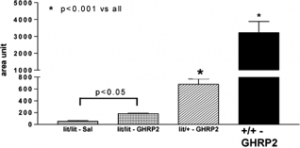
Growth rates of cultured rabbit mesenchymal stem cells in response to the administration of MGF peptide at the concentrations outlined in the legend. From Tong et al., Mechano-growth factor accelerates the proliferation and osteogenic differentiation of rabbit mesenchymal stem cells through the PI3K/AKT pathway. BMC Biochemistry. 2015;16(1):1.
Mechano-growth factor peptide (MGF peptide) is a 24-amino acid carboxy-terminal fragment of the insulin-like growth factor (IGF-1) protein
1. It is a product of IGF-1 mRNA splicing
2. The expression of MGF peptide is related to tissue damage and mechanical stimuli
2. For example, the release of MGF peptide has been observed to increase in response to skeletal muscle injury
3. This is thought to induce hypertrophy in damaged muscle tissue
4. Some proteins found in muscle, such as titin and myomesin, are associated with the expression of this peptide in cultured murine myoblasts and myotubes
2. The mechanical stimuli associated with the normal growth of tissues may also result in the expression of MGF peptide
4. Other forms of stimulus that may be associated with the synthesis of MGF peptide are increased acidity and heat
5. It has been linked to improvements in facets of muscular regeneration. These include delayed myoblast fusion and improved satellite cell proliferation
1. MGF peptide has also been linked to protective roles against the death of nerve and heart muscle cells
2. Therefore, this peptide may have a role in tissue growth and repair
6.
Studies involving MGF Peptide
An
in vitro trial using mouse myoblasts showed that MGF peptide at concentrations of up to 500ng/ml did not increase their proliferation or their differentiation into myotubes
1. To confirm this, the researchers then incubated murine skeletal muscle stem cells with the peptide. No effects on the differentiation or numbers of these cells were observed
1. On the other hand, MGF peptide has been associated with growth and differentiation in other cell and animal types. The exposure of rabbit mesenchymal stem cells to this peptide resulted in their growth and differentiation into osteoblasts
7. This was mediated by the phosphorylation of mTOR and Akt
7. (Conversely, the study as above found no increases in the phosphorylation of Akt in murine heart muscle cells, as claimed in previous reports
1.) Another study using rat osteoblasts found that there was a significant increase in proliferation, and a slight decrease in differentiation, after three days of MGF peptide administration
6. However, after chronic (three weeks) administration, improved differentiation of these cells was observed
6.
Mouse models of myocardial infarction may be characterized by a significant decline in diastolic and systolic hemodynamics as well as pathological hypertrophy within approximately ten weeks of an infarction
8. The administration of MGF peptide within 12 hours of these events in mice had a positive effect on these hemodynamics, but not on hypertrophy
8. MGF peptide administration for eight weeks following infarctions resulted in significant improvement in systolic function
8. Another study assessed the expression of MGF peptide in the growth plates of piglets
4. Porcine Mgf mRNA was found to be increased in the hypertrophic parts of growth plates
4. However, the administration of exogenous MGF peptide to cultures of growth plate cells or chondrocytes did not result in proliferation
4. A study of the effects of MGF peptide on rat mesenchymal stem cells found that this may enhance the stiffness and traction force associated with the migration of these cells
9. The phosphorylation of ERK was associated with MGF peptide-induced migration
9. Repetitive stretching in muscles of Wistar rats was associated with the significantly increased expression of Mgf mRNA, but only in the presence of the anabolic steroid metenolone
10.
References:
1. Fornaro M, Hinken AC, Needle S, et al. Mechano-growth factor peptide, the COOH terminus of unprocessed insulin-like growth factor 1, has no apparent effect on myoblasts or primary muscle stem cells.
American journal of physiology. Endocrinology and metabolism. 2014;306(2):E150-156.
2. Kravchenko IV, Furalyov VA, Popov VO. Stimulation of mechano-growth factor expression by myofibrillar proteins in murine myoblasts and myotubes.
Molecular and cellular biochemistry. 2012;363(1-2):347-355.
3. Vassilakos G, Philippou A, Tsakiroglou P, Koutsilieris M. Biological activity of the e domain of the IGF-1Ec as addressed by synthetic peptides.
Hormones (Athens, Greece). 2014;13(2):182-196.
4. Schlegel W, Raimann A, Halbauer D, et al. Insulin-like growth factor I (IGF-1) Ec/Mechano Growth factor--a splice variant of IGF-1 within the growth plate.
PloS one. 2013;8(10):e76133.
5. Kravchenko IV, Furalyov VA, Popov VO. Hyperthermia and acidification stimulate mechano-growth factor synthesis in murine myoblasts and myotubes.
Biochemical and biophysical research communications. 2008;375(2):271-274.
6. Xin J, Wang Y, Wang Z, Lin F. Functional and transcriptomic analysis of the regulation of osteoblasts by mechano-growth factor E peptide.
Biotechnology and applied biochemistry. 2014;61(2):193-201.
7. Tong Y, Feng W, Wu Y, Lv H, Jia Y, Jiang D. Mechano-growth factor accelerates the proliferation and osteogenic differentiation of rabbit mesenchymal stem cells through the PI3K/AKT pathway.
BMC biochemistry. 2015;16(1):1.
8. Shioura K, Pena J, Goldspink P. Administration of a Synthetic Peptide Derived from the E-domain Region of Mechano-Growth Factor Delays Decompensation Following Myocardial Infarction.
International journal of cardiovascular research. 2014;3(3):1000169.
9. Wu J, Wu K, Lin F, et al. Mechano-growth factor induces migration of rat mesenchymal stem cells by altering its mechanical properties and activating ERK pathway.
Biochemical and biophysical research communications. 2013;441(1):202-207.
10. Ikeda S, Kamikawa Y, Ohwatashi A, Harada K, Yoshida A. The effect of anabolic steroid administration on passive stretching-induced expression of mechano-growth factor in skeletal muscle.
TheScientificWorldJournal. 2013;2013:313605.






